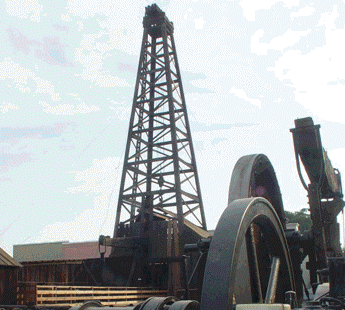

The story of oil, its importance to California from the first explorations and discoveries, and how it has evolved into such a major facet of our economy, is all told in graphic detail in a remarkable exhibition at the Kern County Museum located in Bakersfield.
Entitled "Black Gold: the Oil Experience" the exhibit was seven years in the making and on a recent Sunday celebrated its First Anniversary by adding a Time Capsule containing much information current to the present but sealed for opening 100 years in the future.
In California, both past and present, when you talk about oil Kern County rates as number one. The first wildcatters discovered rich deposits of oil in the early decades of the 20th century in famous areas like Elk Hills and South Belridge, and from those early beginnings to the present, Kern County has always been the leader in the State's oil production.
The Black Gold Museum tells this exciting story in wonderful detail with hands on exhibits tracing how early geologists looked for oil and how their methods have moved on to present day searches from satellites high about the earth in space.
There is a theater of 63 seats which gives visitors an introduction to finding and producing oil with a 17 minute film. Then into as realistic diving bell which takes visitors on a visual reality voyage to the bottom of the sea and then through the four indispensable rock layers required to produce an oil field.
There are many photos of the early days of 'wildcatting' for Kern County oil and exhibits on how the 'roughnecks' lived complete with furniture and appliances of the period.
Every aspect of oil production, from evolving methods of finding oil fields, to the building and use of early derricks, and the bits that dug through strata of rock for the black gold are shown here.
At this Museum adults and children alike have hands on opportunities to twist valves, check the types of oil produced, whether heavy or light crude, and use the space age equipment that seeks new oil fields.
For adults and children alike the exhibit is a fascinating, not soon to be forgotten, experience.
One exhibit shows a modern gas station pump with a spinning dial that calulcates how much gasoline Californians consume each and every day. Guess how much? Forty million gallons of gasoline are used each and every day by California motorists. As you leave the $4 million dollar exhibit you pass some 200 everyday products that contain petroleum.
But it is only half of what awaits the visitor to the Kern County Museum. Spread on 16 acres of parkland is a collection of 53 historic buildings entitled the "Pioneer Village' depicting the life and times of Kern County residents in the last half of the 19th century.
Here you can look into a log cabin built on a nearby ranch in 1868 or the stately mansion used by one of the County's most affluent citizens. This collection is a complete village with a drug store, hospital, school, church, photography shop, courthouse, jail, doctor's office, hotel and much more.
There is a Southern Pacific steam locomotive and an Atchinson, Topeka and Santa Fe Caboose on display. Here too is one of the original oil derricks constructed of massive redwood timbers and the tools and hardware that were required. Also an original pump, again constructed totally of huge wooden beams.
This Writer was fortunate to attend the First Anniversary Celebration, participating in the field type barbecue hosted by Halliburton and some remarks by city and state officials. Jeff Nickell, Lead Curator, gave us a personal guided tour of the Black Gold exhibit.
We also met with Carola Rupert Eriquez, Museum Director and Jackie Brouillette, Education Director, who provided us with both hospitality and much information. We also spent hours on our own wandering through the Pioneer Village.
The Kern County Museum with its Black Gold Exhibit and unique Village from an earlier era is located at 3801 Chester Avenue with easy access from Highways 99, Interstate 5 and 178.
The Museum is open seven days a week, Monday thru Saturday from 8 a.m to 5 p.m. and on Sunday from noon to five p.m. Admission is $7 for adults, $6 for seniors and $5 for children. The Museum is closed for major holidays.
On a visit here plan on spending many delightful hours in a serene setting as you stroll in a parkland through history.
The Museum is an easy two hour drive from the Los Angeles basin depending on time of day and traffic of course. For more information call 661 852-5000. On the web at www.kcmuseum.org.
Graphic Design by Impact Graphics